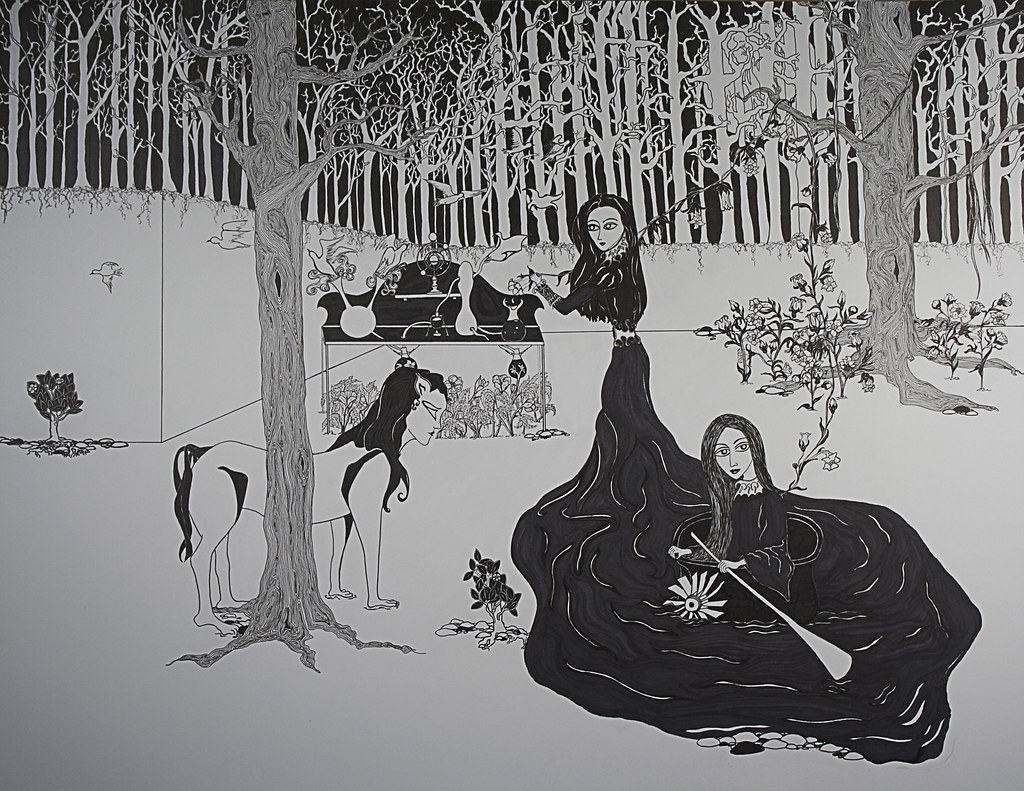
Sunken Garden: Brewing the Birds
black ink on bristol 300 paper, 19 inches x 24 inches
(Note: there are little secrets in this drawing, but you'll have to press the image for a larger version...Have fun!)
This is another drawing for a larger collaboration with Vesna, so I’m just going to put a few notes about what I was thinking about while I was drawing. The overall story involves to young ladies who become neighbors, and a strange garden. Here, it’s a sunken garden, deep in the woods, revealed only at the full moon and in the direct path of the moon beams. Underneath the table are the Hellebores I blogged about here. They are there for the sanity they bring, as defined by me, of course. The flowers and leaves of the Hellebore grow directly into the beakers at the base of the table, and through a system of tubes are brought to mix with the dew forming off the petal of a Canterbury Bell.
Campanula medium (biennial), known as Canterbury Bells: Note that the root of its name, Campana, is Latin for bell. That fits well with the story I found in A Contemplation upon flowers: garden plants in myth and literature (which I keep using, and recommend),
“The source of the common name is an English legend in which three wicked young men were turned into swans by a priest and were forced to fly endlessly for a thousand and one years. On one flight over Canterbury, they heard the nearby ringing of the Christian church bells. They were awed by the sound and the spell was broken [note here: awe breaks the spell of a curse...]. They fell to earth at Canterbury where St. Augustine found them lost and bewildered and led them into the church. As they went inside, little bell-shaped flowers...sprang up from the ground where they stepped. These flowers were dedicated to St. Augustine and later to St. Thomas a Becket, murdered in the cathedral at Canterbury in 1170.”
Some of the variations of the Bellflower give edible roots and salad leaves.
But, as always, on the one side a plant is good, but misused it’s not so good; and it’s important to know the distinctions between the different types of bellflower--and there are more than 300 species:
“The bluebells of Scotland have made their way into legend as well. No one would dream of picking bluebells, for they are the auld-man’s-bell, the bell of the resident ghost of the graveyard who comes out on stormy nights. If one hears his sweet ringing of the bluebells above the thunder, death will come within a fortnight. Hence, the flowers are to remain unmolested, according to legend.”
Here, the birds are miraculously formed (I find that to be a miracle, not a curse!) out of the mists created by the careful mixing and heating of Hellebore essence and the lunar dew formed on the petal of a Canterbury Bell, which has mysteriously grown onto a vine that stretches from the one lady to the other.
Because this is an internal transformation, an alteration of perception to “see” in a more expanded sense, beyond the limitations of the patterns we are raised with and socialized into--beyond those and into that which is so strange we can not even imagine it--she cooks herself in the cauldron, stirring in careful circles around the small pond. To aid her in such a feat, the pot comes equipped with a small mechanical paddling system, which she can turn on by pulling the small cord in her right hand.
Now, I want to revisit the Hellebore a little bit, because it really has a fascinating and illuminating history. In A Contemplation upon Flowers, Ward retells a story Selma Lagerlof recounted from old European legends in the December 1907 issue of Good Housekeeping (Lagerlof was the first woman to win a Nobel Prize for Literature).
“According to her story, long ago, every Christmas Eve a portion of Goinge Forest in Sweden turned into a beautiful garden. The sole witnesses of the transformation, however, were the poor Robber family, who had been banished from the city for stealing a neighbor’s cow for food. Hoping to get her husband pardoned, the exiled wife agreed to reveal the location of the flower garden to the abbot and a gardener brother one Christmas Eve. The brother, jealous because his own garden in the abbey was not nearly so beautiful as that in the forest, cursed the garden, saying that it must be the work of the Evil One if the garden was known only to the outlaws. At his words, darkness sank over the garden and it became frozen and covered with snow. The old abbot died in the sudden snow, clutching a pair of roots in his hand...”
Later, the roots were planted in the abbey’s garden, and they began to yearly produce the Christmas Rose.
This claim of the Evil One’s influence, as opposed to miraculous growth, is one that has often been leveled at those with a green thumb and the knowledge to use plants for healing, as we all know from the wretched human history of witch trials, particularly as related to this plant, but it stresses the importance of careful use of knowledge--because what is in one case miraculous can in another be poisonous (too much of a good thing, etc). An interesting comment was made in Scott’s Letters on Demonology and Witchcraft, when he described seeing “Wretches fitter for a course of Hellebore [as a cure to their apparent insanity] than for the stake.” And it’s possible they were on their way to the stake for using Hellebore!
So, as lazy half-knowledge is dangerous, and jealousy of knowledge is dangerous, and fear of the unknown that others are bringing to light is dangerous, these miraculous things are often kept secret, their effects circulate slowly, and so there is still suffering. And these dangers, all associated with knowledge and gardens and women, well... they are an old story.































































